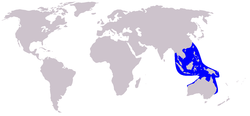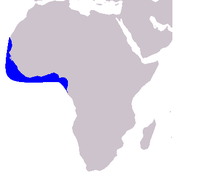Humpback dolphin
|
|
| Humpback dolphins Conservation status: Unknown | ||||||||||||||
|---|---|---|---|---|---|---|---|---|---|---|---|---|---|---|
| Scientific classification | ||||||||||||||
| ||||||||||||||
| Binomial name | ||||||||||||||
| Sousa chinensis | ||||||||||||||
 Pacific Humpback Dolphin (Chinese White Dolphin) range | ||||||||||||||
| Binomial name | ||||||||||||||
| Sousa plumbea | ||||||||||||||
 Indian Humpback Dolphin range | ||||||||||||||
| Binomial name | ||||||||||||||
| Sousa teuszi | ||||||||||||||
 Atlantic Humpback Dolphin range |
The humpback dolphins are the members of the genus Sousa. These dolphins are characterized by the conspicuous humps and elongated dorsal fins found on the back of adult members of the species. They are found close to shore along the coast of West Africa (Atlantic species/variety) and right along the coast of the Indian Ocean from South Africa to Australia (Indo-Pacific species/varieties).
| Contents |
Taxonomy
The taxonomy of the Sousa genus is complicated and disputed. As many as five species have been proposed - S. chinensis (Humpback Dolphin/Indo-Pacific Humpback Dolpin/Pacific Humpback Dolphin), S. plumbea (Indian Humpback Dolphin/Plumbeous Humpback Dolphin), S. teuszi (Atlantic Humpback Dolphin), S. lentiginosa and S. borneensis. By the mid-1990s most authorities (see e.g. [3],[4],[5]) accepted just two species - the Atlantic and the Indo-Pacific. Rice however in his widely used 1998 systematic account ([1]) identified three species - viewing the Indo-Pacific as two species named simply the Indian and Pacific. The dividing line between the two (sub)species is taken to be Sumatra, one of the Indonesian islands, however inter-mixing is thought inevitable.
Further, in [2], Australian cetologist Graham Ross writes "However, recent morphological studies, somewhat supported equivocally by genetic analyses, indicate that there is a single, variable species for which the name S. chinensis has priority".
Humpback dolphins found in Chinese waters are locally known as Chinese White Dolphins. See that article for specific issues relating to that subspecies which corresponds to the Pacific Humpback Dolphin in Rice's classification.
Physical description
The Humpback Dolphins have a distinct surfacing pattern - rising at an angle of 30-45 degrees.
The two Indo-Pacific subspecies differ in colour, and the size of their dorsal fin. The ones found in Southeast Asia have pinkish white skin and have larger dorsal fins, but they lack the fatty humps of their South African and Australian counterparts. Adult Indo-Pacific dolphins can be 2-3 metres in length.
Population and distribution
Human interaction
References
- Marine Mammals of the World. Systematics and Distribution, Dale W. Rice (1998). Published by the Society of Marine Mammalogy as Special Publication No. 4
- Humpback Dolphins Graham J. B. Ross pps 585-589 in Encyclopedia of Marine Mammals (1998) ISBN 0125513402
- National Audubon Society Guide to Marine Mammals of the World (2002) ISBN 037541140
- Cetacean Societies: Field Studies of Whales and Dolphins Mann, Connor, Tyack and Whitehead (2000) ISBN 022650341.
- Whales, Dolphins and Porpoises Mark Carwardine 1995, ISBN 0751327816de:Sousa (Delfin)
